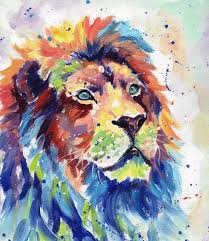The Majestic Lion: A Timeless Subject in Art
Throughout history, the lion has been a symbol of strength, courage, and majesty. Its regal presence and fierce beauty have captivated artists for centuries, inspiring some of the most iconic works of art. From ancient cave paintings to modern masterpieces, the lion has remained a timeless subject that continues to evoke awe and admiration.
One of the most famous lion paintings is “Lion at Rest” by Sir Edwin Landseer, which depicts a majestic lion in repose, exuding a sense of calm power and dignity. The attention to detail in the painting captures not only the physical characteristics of the lion but also its inner essence – a potent combination that resonates with viewers on a profound level.
Another notable example is “The Lion Hunt” by Peter Paul Rubens, a dynamic and dramatic portrayal of a hunting scene where lions are depicted in all their wild glory. The intensity of the composition and the skillful use of light and shadow create a sense of movement and tension that is palpable to the viewer.
Contemporary artists continue to find inspiration in the lion as a subject for their work. Through various styles and mediums, they explore different facets of this magnificent creature – its strength, vulnerability, grace, and ferocity. Each interpretation adds to the rich tapestry of lion art, showcasing the enduring appeal and versatility of this iconic animal.
Whether portrayed realistically or symbolically, lions in art serve as powerful reminders of our connection to nature and our fascination with creatures that embody both beauty and danger. They invite us to contemplate our place in the world and reflect on themes such as power dynamics, survival instincts, and the cycle of life.
In conclusion, the lion remains an enduring muse for artists across cultures and time periods. Its symbolic significance transcends boundaries and speaks to something primal within us all. As we gaze upon these magnificent creatures immortalised on canvas, we are reminded of our shared humanity and our eternal quest to capture the essence of life through art.
Mastering the Majesty: Five Essential Tips for Realistic Lion Painting
- Study lion anatomy to understand their proportions and features.
- Use a variety of brown, yellow, and orange tones to capture the lion’s fur colour realistically.
- Pay attention to light and shadow to create depth and dimension in your lion painting.
- Experiment with different brush strokes to mimic the texture of a lion’s mane or fur.
- Consider the background of your painting to complement and enhance the presence of the lion.
Study lion anatomy to understand their proportions and features.
To truly capture the essence of a lion in painting, it is essential to study their anatomy in depth. Understanding the proportions and features of a lion, from the muscular build to the distinctive mane and facial expressions, allows artists to depict these majestic creatures with accuracy and authenticity. By delving into the intricacies of lion anatomy, artists can breathe life into their paintings, conveying not just the physical form but also the spirit and presence that make lions such compelling subjects in art.
Use a variety of brown, yellow, and orange tones to capture the lion’s fur colour realistically.
To authentically depict the rich and intricate fur colour of a lion in a painting, it is advisable to employ a diverse palette of brown, yellow, and orange tones. By blending these hues with precision and subtlety, artists can recreate the natural warmth and depth of the lion’s coat, bringing forth a lifelike representation that captures the essence of this majestic creature. The interplay of these earthy tones not only conveys the visual texture of the fur but also evokes the inherent vibrancy and vitality that define the lion’s distinctive appearance.
Pay attention to light and shadow to create depth and dimension in your lion painting.
When painting a lion, it is crucial to pay close attention to light and shadow to effectively capture the depth and dimension of this majestic creature. By skillfully manipulating light and shadow in your artwork, you can enhance the three-dimensional quality of the lion’s features, bringing them to life on the canvas. Shadows can help define the contours of the lion’s form, while highlights can accentuate its muscles and fur texture, creating a sense of realism and presence in your painting. Mastering the interplay of light and shadow is key to imbuing your lion painting with a sense of depth and vitality that truly captures the essence of this powerful animal.
Experiment with different brush strokes to mimic the texture of a lion’s mane or fur.
To truly capture the essence of a lion’s mane or fur in a painting, it is essential to experiment with a variety of brush strokes. By exploring different techniques and textures, artists can effectively mimic the intricate details and depth of a lion’s majestic coat. Using varying brush sizes, pressures, and movements can help create the rich and tactile quality that defines the unique texture of a lion’s mane, adding realism and dimension to the artwork. Experimenting with brush strokes not only enhances the visual appeal of the painting but also allows for a more immersive and engaging portrayal of this iconic creature’s beauty and strength.
Consider the background of your painting to complement and enhance the presence of the lion.
When creating a lion painting, it is crucial to consider the background as a vital element that can significantly impact the overall composition. The background serves not only as a setting but also as a means to highlight and enhance the majestic presence of the lion. By choosing complementary colours, textures, or motifs in the background, artists can create a harmonious balance that draws attention to the lion while adding depth and context to the artwork. A well-thought-out background can elevate the impact of the lion, creating a visually compelling piece that resonates with viewers on multiple levels.

